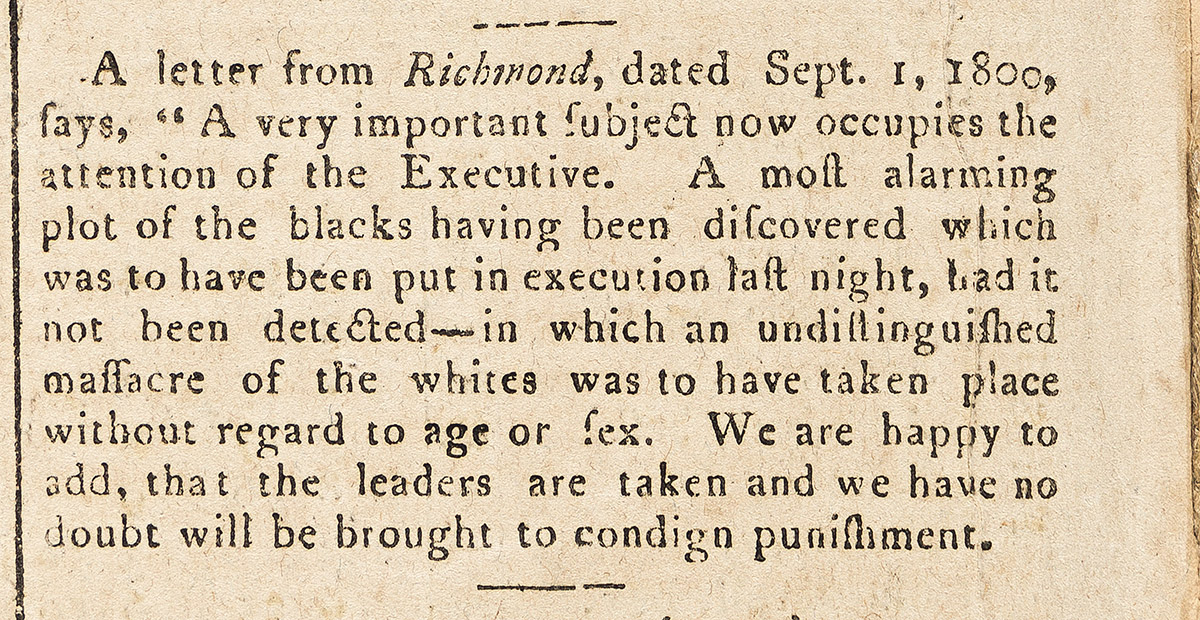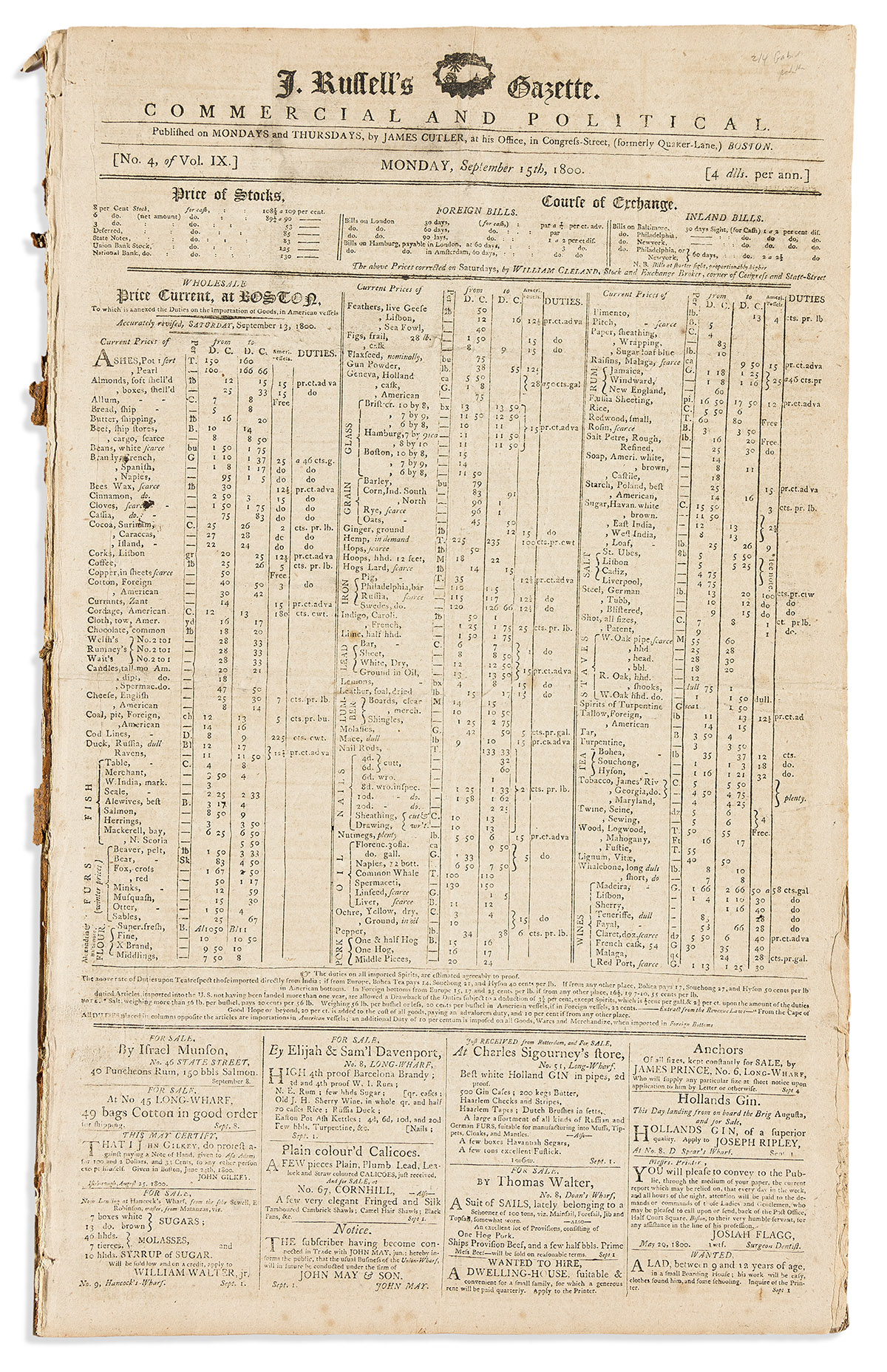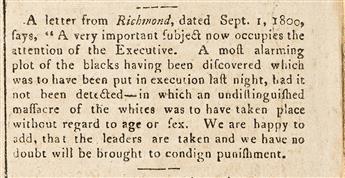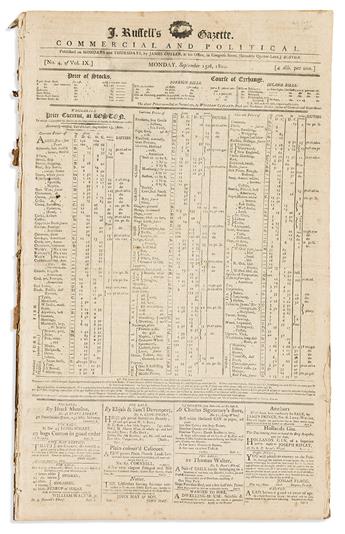Sale 2663 - Lot 392
Unsold
Estimate: $ 1,500 - $ 2,500
(SLAVERY.) Group of Boston Gazettes discussing Gabriel's Rebellion in Virginia. 8 issues, each 4 pages, 20 x 12 inches, on one folding sheet, disbound; folds, minimal wear and foxing; subscriber's name "C Sigourney" inked in upper margin of most issues, with two marked with postage to Hartford, CT. Boston: James Cutler, 15 and 29 September, and complete 6-23 October 1800
Additional Details
Gabriel's Rebellion was one of the largest planned slave rebellions in American history. Led by an enslaved blacksmith named Gabriel near Richmond, VA, the conspirators crafted spears and swords, and planned to seize the Virginia State Armory and capture Governor James Monroe. Heavy rains on the designated day thwarted their attack.
The 15 September issue of the Boston Gazette broke the news to Boston readers with a 1 September letter from Richmond, announcing that a thwarted plan for "an undistinguished massacre of the whites was to have taken place without regard to age or sex. We are happy to add, that the leaders are taken and we have no doubt will be brought to condign punishment." The 29 September issue reports that "two Frenchmen were the instigators of the Negro Plot. . . . The sound of French Liberty and Equality in the ears of these blacks, led them to this desperate measure." A longer report on 6 October spells out the plan: "The conspirators were to have seized on the magazine, the treasury, the mills, and the bridges across James River. They were to have entered Richmond in three places with fire and sword, and to have commenced an indiscriminate slaughter--the French only excepted." The capture of the rebellion's leader is noted on 9 October: "On information being given that General Gabriel was on board the three-masted schr. Mary . . . several persons went on board and apprehended him. . . . He was armed with a bayonet and a bludgeon." On 13 October, the paper noted the suspension of trials: "Should they all be found guilty and be executed, it will nearly produce the annihilation of the blacks in that part of the country." The 16 October issue reprints a front-page editorial titled "The Natural Cause of the Insurrection of the Negroes," placing the blame on irresponsible talk of freedom and liberty. The trial of Gabriel is reported on 20 October--he "appeared to be extremely uneasy in his mind" but refused to share details of the conspiracy. Finally, on 23 October is a front-page editorial on the "Negro Insurrection," once again placing the blame on the French, as well as their ally Thomas Jefferson.
The original subscriber was likely Hartford businessman Charles Sigourney (1778-1854), the future husband of important anti-slavery poet Lydia Huntley Sigourney. The biweekly newspaper changed its full name from "J. Russell's Gazette, Commercial and Political" to "Boston Gazette, Commercial and Political" after the 6 October issue.
The 15 September issue of the Boston Gazette broke the news to Boston readers with a 1 September letter from Richmond, announcing that a thwarted plan for "an undistinguished massacre of the whites was to have taken place without regard to age or sex. We are happy to add, that the leaders are taken and we have no doubt will be brought to condign punishment." The 29 September issue reports that "two Frenchmen were the instigators of the Negro Plot. . . . The sound of French Liberty and Equality in the ears of these blacks, led them to this desperate measure." A longer report on 6 October spells out the plan: "The conspirators were to have seized on the magazine, the treasury, the mills, and the bridges across James River. They were to have entered Richmond in three places with fire and sword, and to have commenced an indiscriminate slaughter--the French only excepted." The capture of the rebellion's leader is noted on 9 October: "On information being given that General Gabriel was on board the three-masted schr. Mary . . . several persons went on board and apprehended him. . . . He was armed with a bayonet and a bludgeon." On 13 October, the paper noted the suspension of trials: "Should they all be found guilty and be executed, it will nearly produce the annihilation of the blacks in that part of the country." The 16 October issue reprints a front-page editorial titled "The Natural Cause of the Insurrection of the Negroes," placing the blame on irresponsible talk of freedom and liberty. The trial of Gabriel is reported on 20 October--he "appeared to be extremely uneasy in his mind" but refused to share details of the conspiracy. Finally, on 23 October is a front-page editorial on the "Negro Insurrection," once again placing the blame on the French, as well as their ally Thomas Jefferson.
The original subscriber was likely Hartford businessman Charles Sigourney (1778-1854), the future husband of important anti-slavery poet Lydia Huntley Sigourney. The biweekly newspaper changed its full name from "J. Russell's Gazette, Commercial and Political" to "Boston Gazette, Commercial and Political" after the 6 October issue.
Exhibition Hours
Exhibition Hours
Aliquam vulputate ornare congue. Vestibulum maximus, libero in placerat faucibus, risus nisl molestie massa, ut maximus metus lectus vel lorem.






